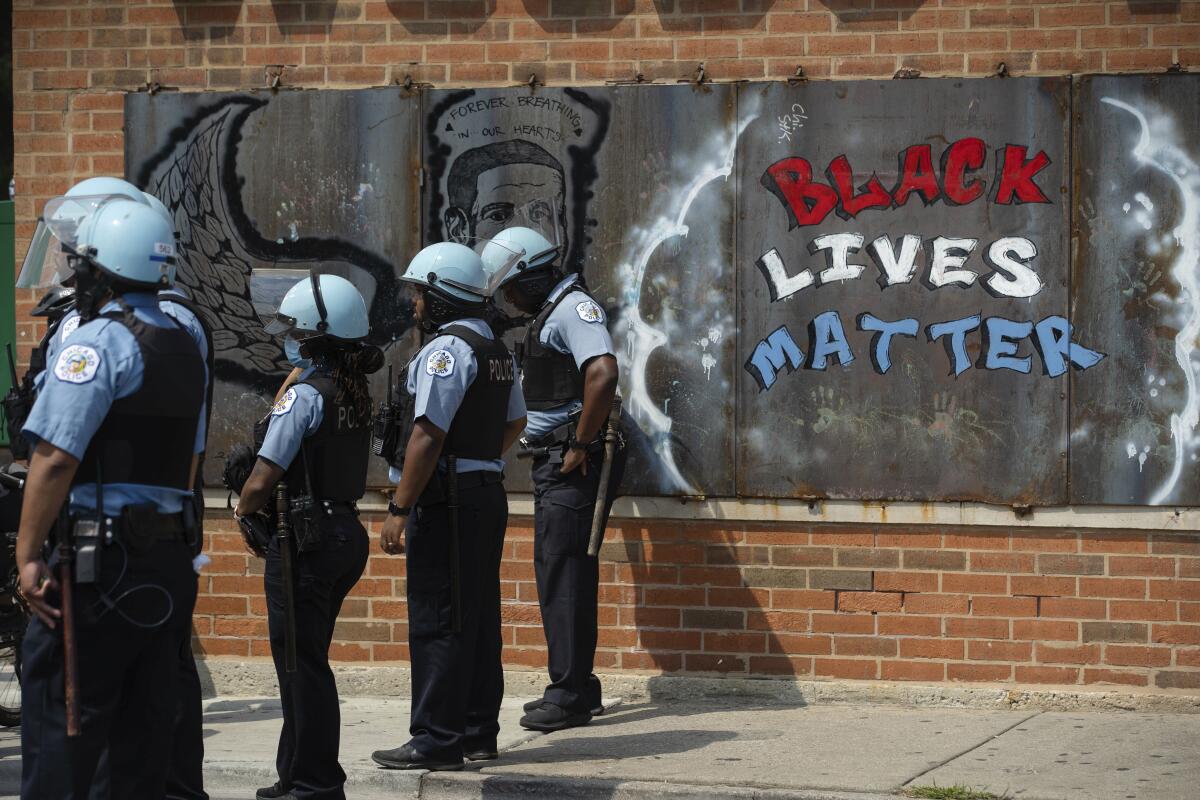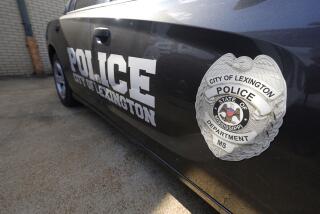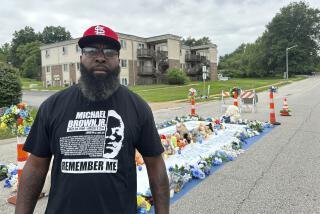Law enforcement diversity may improve policing, study shows

- Share via
CHICAGO — In the last decade, high-profile police killings — including that of George Floyd in 2020 — have shaken the nation and led to widespread protests and calls for reform, including hiring more nonwhite and female officers.
But there was little research to back that up. Now, a new study published Thursday in the journal Science suggests that diversity in law enforcement can indeed lead to improvements in how police treat people of color.
“It’s a system that very clearly needs reforming,” said study coauthor Dean Knox, an assistant professor at the Wharton School of the University of Pennsylvania. “We just haven’t had good data on what reforms work.”
For the paper, Knox and his colleagues analyzed data on nearly 3 million Chicago Police Department patrol assignments. They found that compared to white officers, Black and Latino officers made far fewer stops and arrests — and used force less often — especially against Black civilians. They also found female officers used less force than their male counterparts.
“This is the best evidence to date” that officer demographics have an influence on policing, said Harvard sociologist Joscha Legewie, who was not involved in the study. “It’s an old question, and one that’s really hard to answer.”
Researchers spent three years fighting for detailed data from Chicago police, and appealed some of their requests all the way up to the Illinois attorney general’s office.
“It’s a difficult, difficult thing to pull together these data sources,” said Thaddeus Johnson, a senior fellow at the Council on Criminal Justice and a former Tennessee police officer who was not involved in the study. “This is the kind of research we really need.”
Eventually, the team amassed data on 1.6 million enforcements — such as stops and arrests — by nearly 7,000 officers from 2012 to 2015.
By comparing officers working in similar areas, researchers noticed a difference across demographics. Relative to white officers on the same assignments in the same neighborhoods, Black officers were less likely to stop, arrest and use force against civilians.
Over the course of 100 shifts, Black officers made, on average, about 16 fewer stops and two fewer arrests — a 20% to 30% reduction compared with white officers in comparable scenarios.
“We see two groups of officers going out, and they’re treating the same group of civilians differently,” Knox said. “It’s troubling.”
This disparity was most pronounced in majority-Black neighborhoods, researchers found, and was predominantly focused on minor crimes and not violent offenses.
Most officers respond the same way to violent crimes such as armed robbery or assault. With minor infractions, though, such as traffic violations or drug possession, Legewie said, “there’s more leeway for the officer to make a decision.”
And in recent years, police response to minor infractions has set off many protests against police brutality — including the 2014 killing of 17-year-old Laquan McDonald in Chicago.
“It can escalate,” said coauthor and Princeton University political scientist Jonathan Mummolo. “These can have extreme consequences.”
The new study has its limitations.
Since the information was collected from 2012 to 2015, it doesn’t capture recent changes to policing in Chicago. The paper also doesn’t account for the department’s internal culture, which influences how recruits behave in the field.
And, as a case study of Chicago, the paper is not necessarily generalizable to the country’s more than 18,000 law enforcement agencies, especially suburban and rural ones.
Still, the findings support what local community activists have argued for decades.
“That’s what we expect,” said Regina Russell, co-chair at the Chicago Alliance Against Racist and Political Repression. “That’s why we’ve been pushing for this for years.”
Russell grew up in a predominantly Black area of Chicago, but said the police officers who patrolled her neighborhood were largely white — “Never anyone who looked like us.”
Chicago has long been plagued by tensions between police and residents, roughly half of whom are nonwhite.
Local activists have long called for diversity to reduce the harm of a “racially oppressive police department,” said Simon Balto, who researches history and African American studies at the University of Iowa.
During the early 1960s, Balto said, internal initiatives to increase recruitment helped diversify the Chicago Police Department — an effort further bolstered by a 1973 discrimination suit filed by the city’s Afro-American Patrolmen’s League. “By the ’70s, the CPD wasn’t some beacon of diversity or even representative of the city’s demographics,” Balto said, “but it made strides for the first time in history.”
Today, about half of Chicago Police Department officers are people of color and more than one-fifth are women.
Russell said it was exciting to watch this demographic shift happen in real time. However, she said, “just increasing diversity isn’t going to fix this.”
She and other local activists want to see more body cameras, community oversight of police, stringent use-of-force policies and more consequences for police officers who do harm while on the job.
Others, like Erika Maye, a senior leader for the nonprofit civil rights organization Color of Change, say pushes for diversity are a misstep. “They don’t go deep enough or tackle the root issues,” she said. “Police violence is not an issue of representation.”
Instead, Color of Change advocates for cities to divest from policing and invest in healthcare, education and job training. “To really protect Black lives, we feel we really need to upend the current policing system,” Maye said.
Maye, Russell and Balto said they hope for future research on other reform proposals that center on systemic change, such as initiatives to reduce the size and scope of police departments and reallocate those resources to create crisis intervention teams and other community-based programs.
Mummolo agreed. “We have a lot of policies that were adopted based on hunches or intuitions,” he said.
Data on fatal police encounters, body camera use, civilian complaints and officer political affiliation, for example, could be the focus of future studies.
“This [study] lays out a road map for other researchers,” said coauthor and Columbia University economist Roman Rivera.
More to Read
Sign up for Essential California
The most important California stories and recommendations in your inbox every morning.
You may occasionally receive promotional content from the Los Angeles Times.












